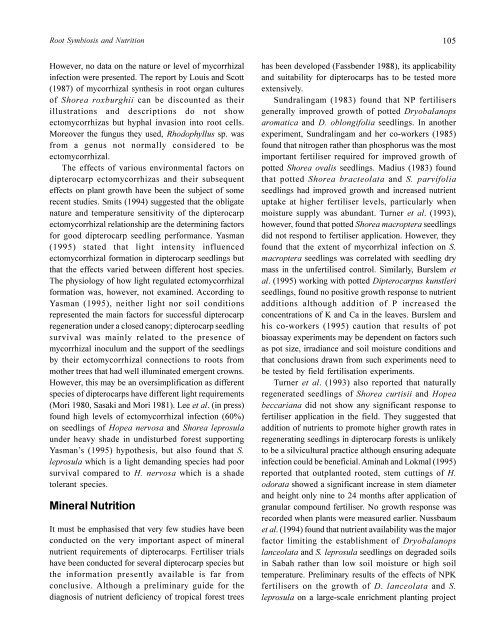A review of dipterocarps - Center for International Forestry Research
A review of dipterocarps - Center for International Forestry Research
A review of dipterocarps - Center for International Forestry Research
Create successful ePaper yourself
Turn your PDF publications into a flip-book with our unique Google optimized e-Paper software.
Root Symbiosis and Nutrition<br />
However, no data on the nature or level <strong>of</strong> mycorrhizal<br />
infection were presented. The report by Louis and Scott<br />
(1987) <strong>of</strong> mycorrhizal synthesis in root organ cultures<br />
<strong>of</strong> Shorea roxburghii can be discounted as their<br />
illustrations and descriptions do not show<br />
ectomycorrhizas but hyphal invasion into root cells.<br />
Moreover the fungus they used, Rhodophyllus sp. was<br />
from a genus not normally considered to be<br />
ectomycorrhizal.<br />
The effects <strong>of</strong> various environmental factors on<br />
dipterocarp ectomycorrhizas and their subsequent<br />
effects on plant growth have been the subject <strong>of</strong> some<br />
recent studies. Smits (1994) suggested that the obligate<br />
nature and temperature sensitivity <strong>of</strong> the dipterocarp<br />
ectomycorrhizal relationship are the determining factors<br />
<strong>for</strong> good dipterocarp seedling per<strong>for</strong>mance. Yasman<br />
(1995) stated that light intensity influenced<br />
ectomycorrhizal <strong>for</strong>mation in dipterocarp seedlings but<br />
that the effects varied between different host species.<br />
The physiology <strong>of</strong> how light regulated ectomycorrhizal<br />
<strong>for</strong>mation was, however, not examined. According to<br />
Yasman (1995), neither light nor soil conditions<br />
represented the main factors <strong>for</strong> successful dipterocarp<br />
regeneration under a closed canopy; dipterocarp seedling<br />
survival was mainly related to the presence <strong>of</strong><br />
mycorrhizal inoculum and the support <strong>of</strong> the seedlings<br />
by their ectomycorrhizal connections to roots from<br />
mother trees that had well illuminated emergent crowns.<br />
However, this may be an oversimplification as different<br />
species <strong>of</strong> <strong>dipterocarps</strong> have different light requirements<br />
(Mori 1980, Sasaki and Mori 1981). Lee et al. (in press)<br />
found high levels <strong>of</strong> ectomycorrhizal infection (60%)<br />
on seedlings <strong>of</strong> Hopea nervosa and Shorea leprosula<br />
under heavy shade in undisturbed <strong>for</strong>est supporting<br />
Yasman’s (1995) hypothesis, but also found that S.<br />
leprosula which is a light demanding species had poor<br />
survival compared to H. nervosa which is a shade<br />
tolerant species.<br />
Mineral Nutrition<br />
It must be emphasised that very few studies have been<br />
conducted on the very important aspect <strong>of</strong> mineral<br />
nutrient requirements <strong>of</strong> <strong>dipterocarps</strong>. Fertiliser trials<br />
have been conducted <strong>for</strong> several dipterocarp species but<br />
the in<strong>for</strong>mation presently available is far from<br />
conclusive. Although a preliminary guide <strong>for</strong> the<br />
diagnosis <strong>of</strong> nutrient deficiency <strong>of</strong> tropical <strong>for</strong>est trees<br />
105<br />
has been developed (Fassbender 1988), its applicability<br />
and suitability <strong>for</strong> <strong>dipterocarps</strong> has to be tested more<br />
extensively.<br />
Sundralingam (1983) found that NP fertilisers<br />
generally improved growth <strong>of</strong> potted Dryobalanops<br />
aromatica and D. oblongifolia seedlings. In another<br />
experiment, Sundralingam and her co-workers (1985)<br />
found that nitrogen rather than phosphorus was the most<br />
important fertiliser required <strong>for</strong> improved growth <strong>of</strong><br />
potted Shorea ovalis seedlings. Madius (1983) found<br />
that potted Shorea bracteolata and S. parvifolia<br />
seedlings had improved growth and increased nutrient<br />
uptake at higher fertiliser levels, particularly when<br />
moisture supply was abundant. Turner et al. (1993),<br />
however, found that potted Shorea macroptera seedlings<br />
did not respond to fertiliser application. However, they<br />
found that the extent <strong>of</strong> mycorrhizal infection on S.<br />
macroptera seedlings was correlated with seedling dry<br />
mass in the unfertilised control. Similarly, Burslem et<br />
al. (1995) working with potted Dipterocarpus kunstleri<br />
seedlings, found no positive growth response to nutrient<br />
additions although addition <strong>of</strong> P increased the<br />
concentrations <strong>of</strong> K and Ca in the leaves. Burslem and<br />
his co-workers (1995) caution that results <strong>of</strong> pot<br />
bioassay experiments may be dependent on factors such<br />
as pot size, irradiance and soil moisture conditions and<br />
that conclusions drawn from such experiments need to<br />
be tested by field fertilisation experiments.<br />
Turner et al. (1993) also reported that naturally<br />
regenerated seedlings <strong>of</strong> Shorea curtisii and Hopea<br />
beccariana did not show any significant response to<br />
fertiliser application in the field. They suggested that<br />
addition <strong>of</strong> nutrients to promote higher growth rates in<br />
regenerating seedlings in dipterocarp <strong>for</strong>ests is unlikely<br />
to be a silvicultural practice although ensuring adequate<br />
infection could be beneficial. Aminah and Lokmal (1995)<br />
reported that outplanted rooted, stem cuttings <strong>of</strong> H.<br />
odorata showed a significant increase in stem diameter<br />
and height only nine to 24 months after application <strong>of</strong><br />
granular compound fertiliser. No growth response was<br />
recorded when plants were measured earlier. Nussbaum<br />
et al. (1994) found that nutrient availability was the major<br />
factor limiting the establishment <strong>of</strong> Dryobalanops<br />
lanceolata and S. leprosula seedlings on degraded soils<br />
in Sabah rather than low soil moisture or high soil<br />
temperature. Preliminary results <strong>of</strong> the effects <strong>of</strong> NPK<br />
fertilisers on the growth <strong>of</strong> D. lanceolata and S.<br />
leprosula on a large-scale enrichment planting project

















